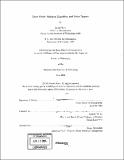| dc.contributor.advisor | Andrew W. Lo. | en_US |
| dc.contributor.author | Rosu, Ioanid, 1970- | en_US |
| dc.contributor.other | Sloan School of Management. | en_US |
| dc.date.accessioned | 2005-10-14T20:33:16Z | |
| dc.date.available | 2005-10-14T20:33:16Z | |
| dc.date.copyright | 2004 | en_US |
| dc.date.issued | 2004 | en_US |
| dc.identifier.uri | http://hdl.handle.net/1721.1/29438 | |
| dc.description | Thesis (Ph. D.)--Massachusetts Institute of Technology, Sloan School of Management, 2004. | en_US |
| dc.description | Includes bibliographical references (p. 99-102). | en_US |
| dc.description.abstract | In this thesis, I explore various aspects of market liquidity and analyze its effect on asset prices. First, in a model of a limit order market I explain how to define liquidity and derive a price impact function. Second, I show how agents who have price impact generate a liquidity component in asset prices. In Part I, I propose a continuous-time model of price formation in a limit-order market. Strategic liquidity traders arrive randomly to the market and dynamically choose between limit and market orders, trading off execution price with waiting costs. I prove the existence of a Markov equilibrium in which the bid and ask prices depend only on the numbers of buy and sell orders in the book, and which can be characterized in closed-form in several cases of interest. My model generates empirically verified implications for the shape of the limit-order book and the dynamics of prices and trades. In particular, I show that buy and sell orders can in some cases cluster away from the bid-ask spread, thus generating a concave price impact function. In Part II, I lay the foundations for the model in Part I by explaining how to define multi- stage games with perfect information in continuous time. In this version, strategies are locally constant and have a finite number of jumps. Also, I allow for the possibility of "stopping the clock." | en_US |
| dc.description.abstract | (cont.) In Part III (joint with Andrew W. Lo and Jiang Wang), we analyze the effects of price impact in a rational infinite-horizon, discrete-time consumption-investment model. We assume that some agents' transactions change prices via an exogenously determined price impact function. Then the resulting equilibrium price, besides the risk premium, displays another component, which depends on the price impact coefficient. We interpret this component as a "liquidity premium." | en_US |
| dc.description.statementofresponsibility | by Ioanid Rosu | en_US |
| dc.format.extent | 102 p. | en_US |
| dc.format.extent | 3814615 bytes | |
| dc.format.extent | 3814422 bytes | |
| dc.format.mimetype | application/pdf | |
| dc.format.mimetype | application/pdf | |
| dc.language.iso | eng | en_US |
| dc.publisher | Massachusetts Institute of Technology | en_US |
| dc.rights | M.I.T. theses are protected by copyright. They may be viewed from this source for any purpose, but reproduction or distribution in any format is prohibited without written permission. See provided URL for inquiries about permission. | en_US |
| dc.rights.uri | http://dspace.mit.edu/handle/1721.1/7582 | |
| dc.subject | Sloan School of Management. | en_US |
| dc.title | Limit order markets, liquidity, and price impact | en_US |
| dc.type | Thesis | en_US |
| dc.description.degree | Ph.D. | en_US |
| dc.contributor.department | Sloan School of Management | |
| dc.identifier.oclc | 56192631 | en_US |

